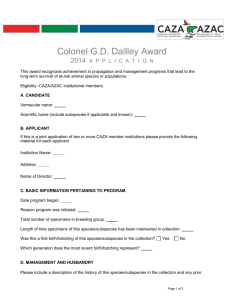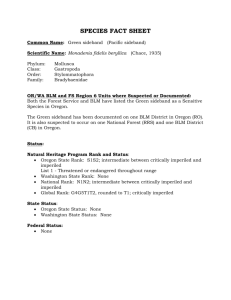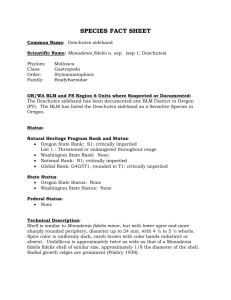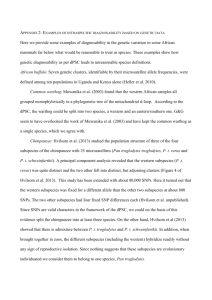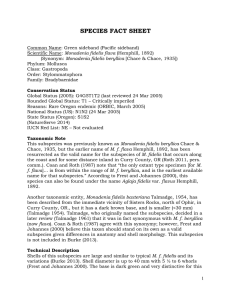SPECIES FACT SHEET
advertisement
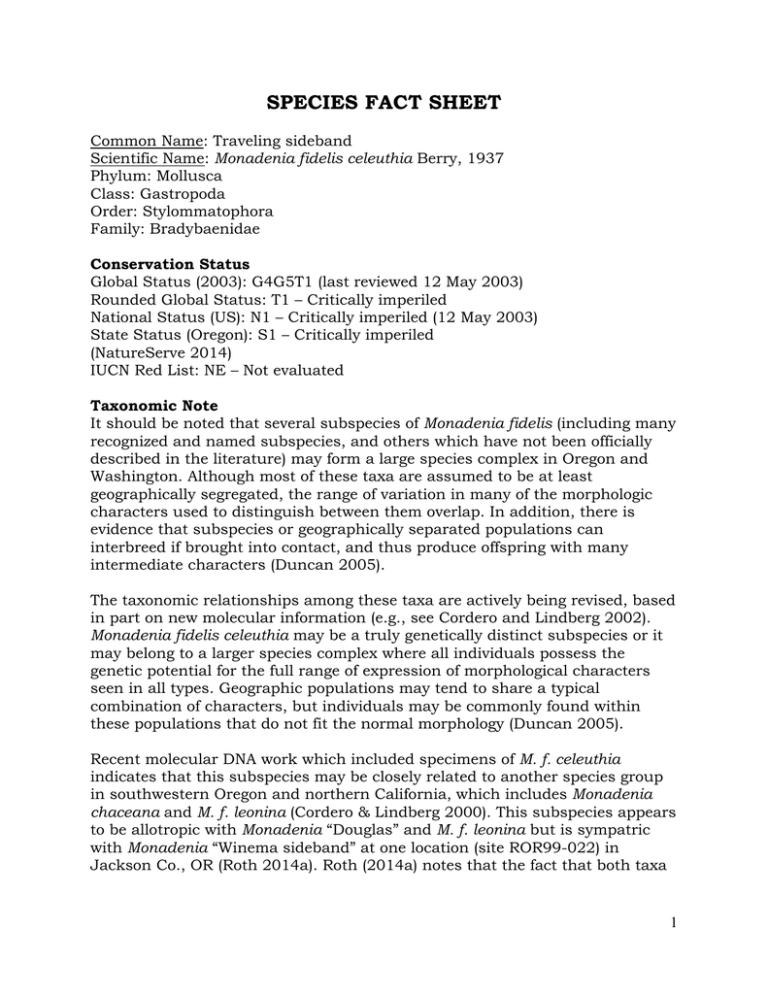
SPECIES FACT SHEET Common Name: Traveling sideband Scientific Name: Monadenia fidelis celeuthia Berry, 1937 Phylum: Mollusca Class: Gastropoda Order: Stylommatophora Family: Bradybaenidae Conservation Status Global Status (2003): G4G5T1 (last reviewed 12 May 2003) Rounded Global Status: T1 – Critically imperiled National Status (US): N1 – Critically imperiled (12 May 2003) State Status (Oregon): S1 – Critically imperiled (NatureServe 2014) IUCN Red List: NE – Not evaluated Taxonomic Note It should be noted that several subspecies of Monadenia fidelis (including many recognized and named subspecies, and others which have not been officially described in the literature) may form a large species complex in Oregon and Washington. Although most of these taxa are assumed to be at least geographically segregated, the range of variation in many of the morphologic characters used to distinguish between them overlap. In addition, there is evidence that subspecies or geographically separated populations can interbreed if brought into contact, and thus produce offspring with many intermediate characters (Duncan 2005). The taxonomic relationships among these taxa are actively being revised, based in part on new molecular information (e.g., see Cordero and Lindberg 2002). Monadenia fidelis celeuthia may be a truly genetically distinct subspecies or it may belong to a larger species complex where all individuals possess the genetic potential for the full range of expression of morphological characters seen in all types. Geographic populations may tend to share a typical combination of characters, but individuals may be commonly found within these populations that do not fit the normal morphology (Duncan 2005). Recent molecular DNA work which included specimens of M. f. celeuthia indicates that this subspecies may be closely related to another species group in southwestern Oregon and northern California, which includes Monadenia chaceana and M. f. leonina (Cordero & Lindberg 2000). This subspecies appears to be allotropic with Monadenia “Douglas” and M. f. leonina but is sympatric with Monadenia “Winema sideband” at one location (site ROR99-022) in Jackson Co., OR (Roth 2014a). Roth (2014a) notes that the fact that both taxa 1 are sympatric while maintaining their morphological identity suggests that the two are separate species rather than subspecies of a single species. Technical Description The shell is of moderate size (25-31 mm diameter, average 19.3 mm height, “usually fairly well elevated” according to Pilsbry 1939:41 or 27-30 mm diameter and 17-19 mm high according to Burke 2013), with 6 to 6 ½ whorls and a narrow umbilicus (width from 1/9 to 1/10 total diameter of shell) permeable to apex. The umbilicus is nearly half-covered by the reflected columellar lip margin (Burke 2013). Its spire is moderately to fairly high and “straw-colored or pinkish- to orange-brown” (Roth 2014a). Its base is “from chestnut to a dark liver brown (Berry, cited in Burke 2013). “The aperture is widely lunate; the lip is narrowly reflected from the outer margin to the columellar insertion, strongly so basally. It has the typical peripheral banding, plus its distinguishing characteristic – multiple bands of varying shades of brown and buff on the spire” (Burke 2013). Pilsbry (1939) notes strong radial growth ridges, with delicate spiral grooves on all but embryonic whorls. Roth (2014a:15) reports the following characteristics from specimens identified as M. f. celeuthia in a M. chaceana study (note that samples submitted for this study were chosen largely because of their small shell size and potential for being M. chaceana, and thus they may not be representative of the subspecies): “Base blackish brown; spire straw-colored or pinkish- to orange-brown, most often without banding although band traces may be present. Periostracum with waxy luster. Shell under periostracum smooth, usually lacking papillae although occasionally some are formed on the summits of collabral rugae. Spiral striation weak to absent. Collabral rugae weak. Spire medium to highconic; embryonic whorls not notably projecting. Medium-sized to large for the species, with adults in this study ranging from 28.7 to 37.4 mm in diameter.” Life History The traveling sideband is an Oregon endemic terrestrial snail. While the biology of this subspecies is not well understood, the parent species is known to be mainly crepuscular (active at dawn and dusk) during the moist spring and fall seasons. During the summer, snails aestivate deep in talus accumulations adjacent to streams or springs, which serve as refuge sites from desiccation. In moister seasons, daily refugia can include down wood, rock, or accumulations of litter. Monadenia species are also known to aestivate under moss and lichen on maple trees (Acer spp.). Snails will climb trees in riparian corridors and shelter in deep forest floor litter (Roth 1993, cited in Frest & Johannes 2000). The diet of the traveling sideband is not known, but other Monadenia species feed on a variety of fungi and plants. Most Monadenia have life spans of 10-15 2 years, are slow growing, and may not reach maturity for 8-10 years (Perez & Cordeiro 2008). Range, Distribution, and Abundance Range: The traveling sideband is known from southwest Oregon and extreme northwest California (Del Norte and Siskiyou Counties). In Oregon, it has been documented at low to moderate elevations from Jackson, Douglas, Josephine, and Klamath Counties. It appears to be replaced by the Modoc Rim and Winema sidebands to the east and other Monadenia fidelis subspecies in the Rogue Valley to the west (Duncan 2005, Frest and Johannes 2000). The Modoc Rim sideband (M. fidelis ssp. nov.) or one much like it may replace M. f. celeuthia in a limited area west of the Cascades Crest, particularly in the eastern third of Jackson County at moderate to high elevations along Little Butte Creek and possibly along the Klamath River drainage portions of southern Jackson County (Frest and Johannes 2000). Frest and Johannes (2000) believe that most material resembling M. fidelis in SW Oregon, and some in NW California, should be regarded as subspecies of celeuthia. The extent of the ranges of subspecies of Monadenia fidelis is typically limited, with each subspecies being described from a portion of a physiographic province or even a single county. Where the ranges overlap, significant mixing occurs and intermediate forms are common. For example, this taxon may intergrade (merge gradually as different species through evolution) with Monadenia chaceana and other Monadenia fidelis subspecies in this area, and with the Modoc and Winema sidebands in the east. Roth (2014a) suggests that individuals of M. f. leonina from Siskiyou County, CA, may represent intergradation with M. f. celeuthia or other taxa. Distribution: The type locality for this subspecies is “trail, Rogue R. valley, Jackson Co., OR” (Frest and Johannes 1993). The original known distribution of this taxon was at three sites in the Rogue River Valley (Pilsbry 1939, Roth 1993, cited in Frest and Johannes 1993). This subspecies is now known to have a broad distribution in Josephine and Jackson Counties and southern Douglas County, OR, with a few records in western Klamath County and far northern Del Norte and Siskiyou Counties, CA. OR/WA BLM and FS Region 6 Units where Suspected or Documented: Both the Forest Service and BLM have listed the traveling sideband as a Sensitive Species in Oregon. It has been documented on the Medford and Roseburg BLM Districts and the Umpqua and Rogue River Siskiyou National Forests. Three snails identified as celeuthia were also observed on the FremontWinema National Forest in 2010, although these sightings have not been confirmed by a mollusk expert. 3 Abundance: Population densities at known sites have not been conducted for this subspecies; however, most collections have included only one to six or seven individuals. Habitat Associations The parent species, Monadenia fidelis, is found in mesic forest habitats or near springs or other water sources in forest situations, generally with rock substrates or large woody debris and logs for refugia (Frest and Johannes 1995, 2000). Many species are known to be arboreal, climbing trees to forage on lichens and using moss accumulations in the canopy as possible refugia sites in winter. The M. f. celeuthia subspecies is found at low elevation in unaltered, somewhat dry and open forested terrain (Frest and Johannes 2000). It can be found in basal talus and rock outcrops with oak and maple overstory component; along spring runs in rocks and moist vegetation and moss within mixed coniferhardwood forest (western red cedar and maple); and in very moist, silty alluvial benches adjacent to creeks in mixed conifer-hardwood forest (western red cedar, Douglas fir and big-leaf maple) (Duncan 2005). Frest and Johannes (1993) suggest that it is likely an old growth and riparian associate. Threats Logging and grazing in limited areas of occurrence pose threats to this species (Frest and Johannes 2000). Removal or reduction of forest canopy and increased sun exposure from logging or other habitat altering or removal activities can result in drying of important subterranean refugia sites, reduction in fungal food sources and loss of aestivating individuals. Since many members of this genus are arboreal, at least during portions of the year, tree falling may result in direct mortality to individuals in the trees. Bigleaf maples or other species with heavy accumulations of mosses are heavily used for microhabitat sites, especially by juveniles. Concentrated use of riparian areas by livestock may also degrade available loose soil and litter habitat components used for foraging and breeding (Duncan 2005). See extensive review of effects of forest land management on terrestrial mollusks by Foltz Jordan and Black (2012). Conservation Considerations Inventory and monitoring: Known sites on public lands should be monitored routinely to understand population size and trends and to determine which factors affect these trends. Additional surveys could be conducted to locate new populations in areas identified as potential habitat. Research: Population size, trends, and abundance are all unknown for this subspecies. In addition, habitat requirements and food preferences are poorly known. Historically, most distinctions in M. fidelis subspecies have been based on differences in shell morphology; however, individuals with intermediate 4 characters are known from several sites, and morphological characters may not be adequate for differentiating the various subspecies of M. fidelis. This genus would benefit from genetic work; little molecular work has been done on the group as a whole to establish taxonomic relationships at the DNA level. Until these relationships are worked out, it may be helpful to reexamine collections of M. f. celeuthia to confirm specimen identifications to the extent possible and to better understand the extent of this subspecies’ range in southwest Oregon (see Roth 2014a, 2014b, for recent morphological examinations of M. fidelis subspecies). Management: Maintain areas of undisturbed forest, preferably around important habitat features such as moist rock talus and outcrops, old growth forest, large down woody debris, and riparian areas. Connectivity between sites may be important for localized dispersal. Minimize management activities at known sites to avoid soil compaction and destruction of habitat. Version 2 Prepared by Candace Fallon (Xerces Society), March 2015 Edited by Sarina Jepsen (Xerces Society), March 2015 Version 1 Prepared by Theresa Stone (USFS – UMP) Date completed: December 2009 Edited by: Rob Huff (ISSSSP) Date: May 2010 ATTACHMENTS: (1) References (2) List of pertinent or knowledgeable contacts (3) Map of known records in Oregon (4) Photographs of this subspecies (5) Gastropoda Survey Protocol, including specifics for this subspecies 1: References Burke, T. 2013. Land Snails and Slugs of the Pacific Northwest. Oregon State University Press, Corvallis OR. 344 pp. Cordero, Alicia and David R. Lindberg. 2002. Molecular phylogeny of some land snails of the clades Monadenia and Helminthoglypta in Southern Oregon and Northern California. Final Report to the BLM Roseburg District Office. Duncan, N. 2005. Personal communication with Theresa Stone. 5 Frest, T.J. and E.J. Johannes. 1993. Mollusc species of special concern within the range of the northern spotted owl. Final report to Forest Ecosystem Management Working Group, USDA Forest Service. Deixis Consultants, Seattle, WA. 156 pp. + appendix. Frest, T. J., and E. J. Johannes. 1995. Interior Columbia Basin mollusk species of special concern. Final report: Interior Columbia Basin Ecosystem Management Project, Walla Walla, WA. Deixis Consultants, Seattle, WA. Contract #43-0E00-4-9112. 274 pp. plus appendices. Frest, T.J. and E.J. Johannes. 2000. A Baseline Mollusk Survey of Southwestern Oregon, with Emphasis on the Rogue and Umpqua River Drainages. Deixis Consultants, Seattle, WA. NatureServe. 2014. NatureServe Explorer: An online encyclopedia of life [web application]. Version 7.1. NatureServe, Arlington, Virginia. Available at http://explorer.natureserve.org. (Accessed: February 11, 2015.) Perez, K.E. and J.R. Cordeiro. 2008. A guide for terrestrial Gastropod identification. Proceedings of the Terrestrial Gastropod Identification Workshop. Southern Illinois University, Carbondale, Illinois. Pilsbry. 1939. Land Mollusca of North America (North of Mexico), Volume 1, Part I. Academy of Natural Sciences of Philadelphia, p. 41-42. Roth, B. 1993. Critical review of terrestrial mollusks associated with latesuccessional and old-growth forests in the range of the northern spotted owl. Final report to Forest Ecosystem Management Working Group, USDA Forest Service. Barry Roth, San Francisco. 42 pp. Roth, B. 2014a. Identification and distribution of the land snail Monadenia chaceana and similar species. A report in partial fulfillment of USDA Forest Service Purchase Order AG-046W-P-12-0110. Roth, B. 2014b. Identification of submitted mollusk specimens, Monadenia. Memorandum to Edge Environmental and the Interagency Special Status Species Program. 2: List of Pertinent or Knowledgeable Contacts Taxonomic experts experienced with collecting and identifying this subspecies: • • • Barry Roth Ed Johannes, Deixis Consultants Tom Burke 6 3: Map of known records in Oregon Known records of Monadenia fidelis celeuthia in Oregon, relative to Forest Service and BLM land. Records from NW California have not been included. (NOTE: given the taxonomic uncertainty surrounding this subspecies, all of the records contained on this map should be re-evaluated, preferably using genetic analysis, to determine appropriate species/sub-species identification). 7 4: Photographs of this subspecies Monadenia fidelis celeuthia from Josephine Co, Oregon. Scale bar = 1 cm. Photo by William Leonard, from Land Snails and Slugs of the Pacific Northwest (Burke 2013). Used with permission. 5: Gastropoda survey protocol, including specifics for this subspecies Survey Protocol (adapted from Foltz 2009) Taxonomic Group Gastropoda Species Monadenia fidelis celeuthia Please refer to the following documents for detailed mollusk survey methodology: 1. General collection and monitoring methods for both aquatic and terrestrial mollusks (pages 64-71): Frest, T.J. and E.J. Johannes. 1995. Interior Columbia Basin mollusk species of special concern. Final report: Interior Columbia Basin Ecosystem Management Project, Walla Walla, WA. Contract #43-0E00-49112. 274 pp. plus appendices. 2. Pre-disturbance surveys for terrestrial mollusk species, the objective of which is to establish whether a specific mollusk is present in proposed project areas with a reasonable level of confidence, and to document known sites discovered during surveys: Duncan, N., Burke, T., Dowlan, S. and P. Hohenlohe. 2003. Survey protocol for survey and manage terrestrial mollusk species from the Northwest Forest Plan. Version 3.0. U.S. Department of Interior, Bureau 8 of Land Management, Oregon/Washington and U.S. Department of Agriculture, Forest Service, Region 6, U.S. Fish and Wildlife Service. 70 pp. Available at http://www.blm.gov/or/plans/surveyandmanage/files/11mollusks_v3_enclosed2.pdf (last accessed 27 February 2015). Species-specific survey details, including: 1. Identification features 2. Historic and current distribution 3. Federal Units where species is suspected or documented 4. Areas where surveys are recommended 5. Habitat where surveys should take place 6. Commonly associated mollusk species 7. General survey method and instructions (e.g. time of year) Monadenia fidelis celeuthia (Traveling sideband) Monadenia is a genus of pulmonate, terrestrial snails in the family Bradybaenidae. In the Pacific Northwest, this genus is distinguished from similar taxa as follows (Burke 2013): snails of moderate to large size (20 to 40 mm wide) with a moderate to fairly high conic spire and small, open umbilicus. Most are multi-colored (shades of brown and yellow; sometimes white and rarely greenish) with a light band around the periphery, a dark band above it, and a narrower light band above the dark one. The aperture lip is narrowly reflected, at least basally, in fully adult shells. Immature shells are shouldered or angled at the periphery and have granulations on the embryonic whorls. Adult shells mostly have a rounded periphery and are sculptured with spiral striae and growth wrinkles. Monadenia fidelis is the largest native land snail in the Pacific Northwest. Its shell measures 31 to 38 mm wide by 20 to 27 mm high with 6 ½ to 7 ½ whorls [with the exception of M. fidelis minor, which is smaller] (Burke 2013). The spire is moderately to fairly high, conic or a little convex. The last whorl descends rather abruptly to the aperture, which is widely oval, its lip narrowly flared and narrowly reflected basally. The shell is white inside, but the brown color of the base and the peripheral band shows through. The umbilicus is narrow, about one-tenth the shell width. The color pattern varies but is typically dark brown or chestnut basally with a light yellow band at the periphery, a dark brown to black band just above the periphery, and a narrow yellow area above the dark band followed by a blending of the yellow and brown colors on the spire. The resulting color depends on the dominance of those two individual colors. The yellow is often replaced by white, and there are usually radial streaks of brown on the spire behind growth stop lines (Burke 2013). The M. f. celeuthia subspecies is described as follows by Burke (2013): “This subspecies has a shell of medium size for the species. With 6 to 6 ½ whorls it 9 measures 27 to 30 mm wide by 17 to 19 mm high. Its umbilicus is one-ninth to one-tenth the shell width and is nearly half-covered by the reflected columellar lip margin. Its spire is moderately to fairly high and quite dark brown. Its base is “from chestnut to a dark liver brown” (Berry). The aperture is widely lunate; the lip is narrowly reflected from the outer margin to the columellar insertion, strongly so basally. It has the typical peripheral banding, plus its distinguishing characteristic – multiple bands of varying shades of brown and buff on the spire.” This subspecies occurs primarily in Jackson County and the adjacent counties of Klamath, Josephine, and Douglas. It is also known from Del Norte and Siskiyou Counties in California. In Oregon, this subspecies is documented on the Medford and Roseburg BLM Districts and the Umpqua and Rogue River Siskiyou National Forests. It is suspected on the Fremont-Winema National Forest due to three unconfirmed observations. Over 170 records of this subspecies are known from southwest Oregon, however not all of these have been confirmed by mollusk experts. This taxon appears to be well-distributed in the core of its range in Jackson Co. Frest and Johannes (2000) note that Monadenia fidelis ssp. nov. (Modoc Rim sideband) or one much like it may replace M. f. celeuthia in a limited area west of the Cascades Crest, particularly in the eastern third of Jackson County at moderate to high elevations along Little Butte Creek and possibly along the Klamath River drainage portion of southern Jackson County. Specimens of M. f. celeuthia from southern and eastern Jackson County (particularly near the North and South Fork Little Butte Creeks and Antelope Creek) could be reexamined by a mollusk expert to determine whether this taxon is overlapping with another Monadenia sp. in those areas or if records were misidentified and actually represent another Monadenia sp. In addition, it may be worthwhile to reexamine collections from the Spencer Creek area in Klamath County and far north and east Josephine County to verify this subspecies’ range and distribution where overlap with other Monadenia fidelis subspecies is known to occur. Further surveys at the known edges of this subspecies’ range could focus on gathering fresh genetic material for molecular studies to evaluate the relationship between this and other subspecies of M. fidelis in the area. The habitat for this subspecies is described as low elevation in unaltered, somewhat dry and open forested terrain (Frest and Johannes 2000). This subspecies can be found in basal talus and rock outcrops with oak and maple overstory component; along spring runs in rocks and moist vegetation and moss within mixed conifer-hardwood forest (western red cedar and maple); and in very moist, silty alluvial benches adjacent to creeks in mixed coniferhardwood forest (western red cedar, Douglas fir and big-leaf maple) (Duncan 2005). Frest and Johannes (1993) suggest that it is likely an old growth and riparian associate. Most sites with this taxon are seasonally moist, but rather 10 dry, exposed, and rocky in comparison with nearby sites. The taxon appears to favor shaded basalt talus and outcrops, not open talus (Frest and Johannes [n.d.]). Note that mollusks which inhabit rocky habitats also utilize the surrounding forest areas during moist, cool conditions (Foltz Jordan and Black 2014). In winter, the species has been found hibernating under moss (above ground) in the crotches of bigleaf maple trees as well as buried under leaf litter at their bases (Evergreen State College 2008). Downed wood may provide temporary refugia used during dispersal in the wet season, while rock substrates provide more stable refugia used for aestivation during summer and winter, and loose soil is considered necessary for egg laying (Foltz Jordan and Black 2014). Burke (2013) recommends searching for this species under loose hanging mosses and lichens on the trunks of bigleaf maples. Hand collection is the appropriate survey method for this subspecies (Johannes 2009, pers. comm.). At the species level, this taxon appears to be active on the surface mainly in spring (Evergreen State College 2008). Surveys should consider the following (species-level) ecological and seasonal information, taken from the Conservation Assessment for M. f. minor (Foltz Jordan and Black 2014): The species is mainly crepuscular (active only during dawn and dusk) during the moist spring and fall seasons. During the wet seasons, it may be found in the open, away from refugia, foraging for green vegetation and fruit, feces, old leaves, leaf mold, fungi, or microorganisms found on woody debris. Daily refugia used during moist seasons include down wood, rock or accumulations of litter. During the summer, snails are found deep in talus accumulations which are adjacent to springs or streams and which serve as refuge sites from desiccation and protection from predators while they are immobile. These deep rock refugia also provide the important, environmentally stable sites needed to survive wildfire events and cold winter conditions. The distribution of these stable rock refugia sites across the landscape may determine or at least help to explain the distribution of the species in areas with short fire-return intervals. Mollusks which inhabit talus habitats also utilize the surrounding forest areas during moist, cool conditions, ranging out from the refugia provided by the rocks to forage in the adjacent forest floor litter. Vegetation within the surrounding forest not only moderates the temperature and moisture conditions within the rock habitats, but provides food, loose soil and litter conditions necessary for egg laying. Generally, the lower one-third of a talus slope contains the largest, most stable habitat elements. Because of the long-term stability in these areas and larger interstitial spaces between the rocks, microsite conditions are more favorable and provide dependable refugia sites. Other sites with 11 rock-on-rock accumulations, such as are common at the base of rock outcrops, may provide similar crevices. Temperature is lower and humidity is higher under talus than in the surrounding environment. References (survey protocol only): Burke, T. 2013. Land Snails and Slugs of the Pacific Northwest. Oregon State University Press, Corvallis OR. 344 pp. Duncan, N. 2005. Personal communication with Theresa Stone. Duncan, N. 2008. Survey Protocol for Aquatic Mollusk Species: Preliminary Inventory and Presence/Absence Sampling, Version 3.1. Portland, OR. Interagency Special Status/Sensitive Species Program. U.S. Department of Interior, Bureau of Land Management, Oregon/Washington and U.S. Department of Agriculture, Forest Service, Region 6. 52 pp. Evergreen State College. 2008. Monadenia fidelis (J.E. Gray, 1834) Pacific Sideband. Available at: http://academic.evergreen.edu/projects/ants/TESCBiota/mollusc/key/mon_fi d/mon_fid.htm (Last accessed 27 February 2015). Foltz, S. 2009. Mollusk survey protocol. Prepared for the Interagency Special Status Species Program (ISSSSP) by the Xerces Society for Invertebrate Conservation. Foltz Jordan, S. and S. H. Black. 2014. Conservation assessment for Monadenia fidelis minor, Dalles sideband. Updated for the USDA Forest Service Region 6 and USDI Bureau of Land Management, Oregon and Washington. 24 pp. Frest, T.J. and E.J. Johannes. 2000. A Baseline Mollusk Survey of Southwestern Oregon, with Emphasis on the Rogue and Umpqua River Drainages. Deixis Consultants, Seattle, Washington, 403 pp. Frest, T.J. and E.J. Johannes. [n.d.]. Northwestern U.S. sensitive nonmarine mollusks. Unpublished document. Available from E. Johannes. ISSSSP Species Fact Sheet for three subspecies of Monadenia fidelis from Oregon. Unpublished document available on ISSSSP intranet site. Johannes, Ed. 2009. Personal communication with Sarah Foltz, Xerces Society for Invertebrate Conservation. 12 NatureServe. 2014. NatureServe Explorer: An online encyclopedia of life [web application]. Version 7.1. NatureServe, Arlington, Virginia. Available http://explorer.natureserve.org. (Accessed: February 20, 2015). Pilsbry, H.A. 1939. Land Mollusca of North America (North of Mexico), Academy of Natural Sciences of Philadelphia, Monograph 3, Vol 1(1): 1-574. Sources for M. f. celeuthia collection and observation records: The Academy of Natural Sciences: Malacology Collection. Online database. Available at: http://clade.ansp.org/malacology/collections/index.html. (Last accessed July 2009). Burke, Tom. 2015. Personal communication with Candace Fallon, Xerces Society for Invertebrate Conservation. California Academy of Science. Online database. Available at: http://research.calacademy.org/research/izg/iz_coll_db/index.asp. (Last accessed July 2009). Marshall, Chris. 2015. Oregon State Arthropod Collection records. Oregon State University, OR. Santa Barbara Museum of Natural History: Invertebrate Zoology. Online database. Available at: http://www.sbcollections.org/. (Last accessed July 2009). Smithsonian National Museum of Natural History: Invertebrate Zoology Collection. Online database. Available at: http://collections.nmnh.si.edu/emuwebizweb/pages/nmnh/iz/Query.php. (Last accessed July 2009). Stone, Theresa. 2015. National Resource Information System (NRIS) records. USDA Forest Service. Stutzman, Diane. 2015. Geographic Biotic Observations (GeoBOB) records. USDI Bureau of Land Management. Wise, Lindsey. 2015. Oregon Biodiversity Information Center (ORBIC) records. Portland State University, OR. 13

